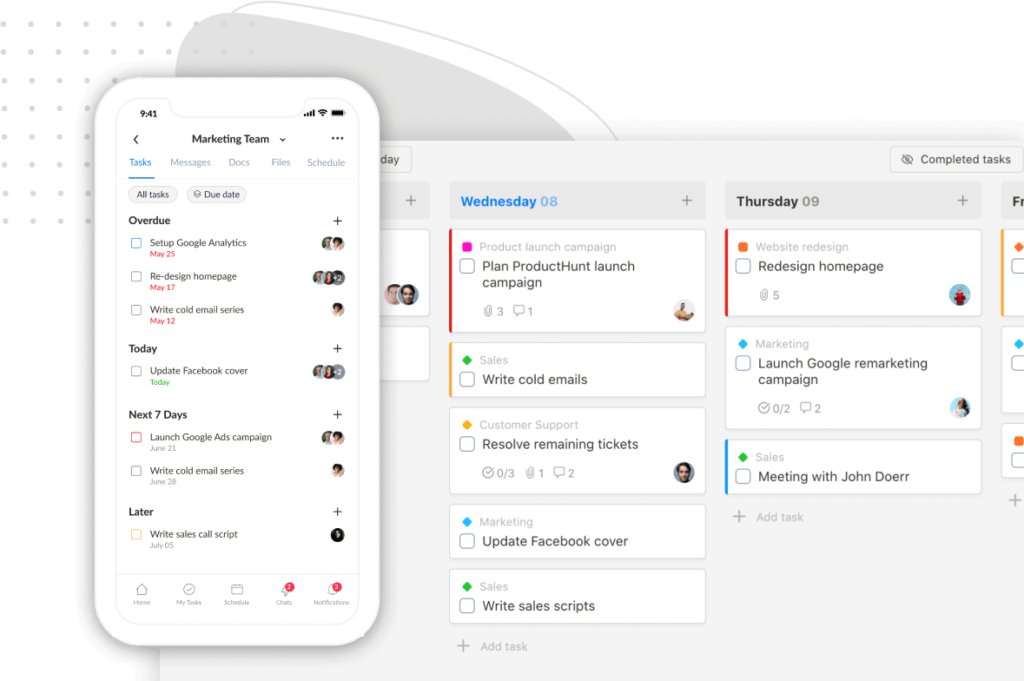You might have heard of the Pomodoro Technique somewhere.
This method often goes with keywords like “productivity improvement”, “procrastination reduction”, “25-minute work sessions”, and “breaks between intervals”.
Do you wonder:
- What is the Pomodoro Technique?
- Why is a time management method related to a tomato-shaped timer?
- Does the Pomodoro Technique work for your productivity?
- Does it really work for you?
Let’s find out together in this blog post.
I. Overview Of The Pomodoro Technique
In this section, we’ll answer these questions:
- What is the Pomodoro Technique?
- Who created the Pomodoro method?
- How does the Pomodoro Technique work?
- How to be 2x productive with the Pomodoro method
1. What is the Pomodoro Technique?
Have you ever been in this situation, feeling like you have an endless workday to get things done and then finally throwing away those precious work hours on distractions?
Deadlines stir up your anxiety?
And time is like your enemy?
If so, we guess you probably often suffer from procrastination, low productivity, and ineffective work. The Pomodoro Technique was created to help you fight these problems.
This technique is a time management method developed in the late 1980s by university student Francesco Cirillo.
The Pomodoro Technique is scientifically proven to help people develop an effective relationship with time, complete multiple tasks efficiently, and boost their productivity with less anxiety.
It uses Pomodoro timers to break down work into 25-minute chunks of work/study time with five-minute short breaks in between.
After four pomodoros, take a longer break, typically 15 to 30 minutes, to stave off mental fatigue and promote sustained concentration.
You might now wonder, “Why is it called Pomodoro Technique?”. Keep reading!
2. Where did the Pomodoro Technique come from? Who is Francesco Cirillo?
As mentioned, Francesco Cirillo created the Pomodoro Technique as a university student.

Cirillo found it so difficult to stay focused on his studies and complete assignments.
And then, he had this idea, studying for just a short interval, but with his best focus.
He used his tomato-shaped kitchen timer and experimented with different study intervals, from two minutes up to one hour in length.
Ultimately, he realized that 25 minutes was the optimal time for him to focus on a task.
Cirillo named these study intervals “Pomodoros”, an Italian word meaning “Tomato”, that are spaced out by short breaks.
Woala, that’s how the tomato-related time management system was born.
3. How does the Pomodoro Technique work
Cirillo wrote a 130-page book about the Pomodoro Technique.
But in brief, here are the six steps to how the Pomodoro technique works:
- Prepare a timer and create a to-do list
- Choose a task, set a timer of 25 minutes, and focus on the task
- Work on the task till the timer alerts you, then take a five-minute break
- Repeat steps the third and fourth steps
- After four Pomodoros, take a 15- to 30-minute long break.
- Once the long break is finished, return to step 2
That’s it! Very simple, right?
But if you want to learn more about tricks to make the most of this method and optimize your productivity, read on!
4. How to be 2x productive with the Pomodoro technique
A. Track your core process
The following simple steps will help you track your productivity and manage your time, hence, figure out the best way of time distribution and plan-making.
Before you get started, set a goal; the number of hours that you keep focused on work, for example.
Then, when you accomplish a Pomodoro session, mark it off, and record what you get done.
After the workday, make a report that includes:
- Total number of your work hours
- Calculation of your work hours against your of-the-day goal
- If you have repetitive work, count the actual work time for each one.
- When an unavoidable disruption happens, take a short break and restart. Don’t forget to record the reason for that disruption and propose a solution
B. Eliminate distractions while you’re working
We’re easily distracted by social media, phone messages, internet surfing, what is going on in other people’s lives, etc.
Timers might not be enough for you to focus on your work.
So, CONSIDER:
- Disconnecting internet connection
- Placing your phone away from your desk
- Turning off social media
If anything pops up in your head during your work time – watching a favorite MV, for example, write it down on a note, place it aside, and get back to work.
You can do it later in your free time.
C. Small tasks go together
Your to-do list will have those tasks that take less than one Pomodoro to complete. Group and complete them in one session.
If you finish all work before the Pomodoro rings, use the remaining time for honing skills, enriching knowledge, or planning the next day.
D. Divide complex projects into smaller steps
For the big project that takes more than four Pomodoros, break it down into smaller tasks. Do the same thing with the large task.
This trick helps make your project progress clear and manageable.
II. Why Pomodoro Technique Is So Effective?
Fact: More than two million people have already used the Pomodoro Technique to optimize their productivity, avoid procrastination, and be consistently focused throughout the day.
But why is it so effective?
The Pomodoro Technique helps:
- Get things done in short bursts
- Ensure you take regular breaks and remain your concentration throughout the day (scientifically proven already)
- Break the habit of multitasking, hence, which improves work quality and avoid being distracted
- Make monotonous work more encouraged to get started
- Bring up a sense of accomplishment and boost your motivation
- Relieve stress and anxiety because you know how to use and manage your time
- Gamify your productivity
However, if you find it hard to track time by using the Pomodoro Technique manually, consider a Pomodoro app.
III. Introducing Upbase – Best Pomodoro Tool
Good Pomodoro tools should have three functions:
- Create and manage to-dos
- Report of Pomodoro progress
- Categorize tasks by projects/lists/…
With that in mind, we designed Upbase’s Focus Timer.
1. Why use Upbase?
Just like you, we are productivity enthusiasts.
We’ve also experienced Pomodoro app testers, which means we have tried many options available.
But in the end, no contender ticked all of our checkboxes. They are either too basic to be helpful or too expensive for long-term use.
We need a tool that’s free, simple to use, and accurate in time-counting but also allows for creating detailed reports and planning. And well…if it can do more than merely a Pomodoro tool, we appreciate it.
Are we asking too much? Maybe yes. That’s why we create our tool with everything we wish for:
- Intuitive and easy to use
- Three flavors to choose from: traditional Pomodoro timers, customizable focus timers, and no-break continuous timers.
- In-depth reports (soon)
- Seamless coordination with other productivity tools, such as Daily, Weekly, and Monthly planners, Notepad, Daily Journal, and Timeboxing.
- Many useful tools, such as Docs, Files, Chat, etc.
2. How to use Upbase’s Timer
Before exploring Upbase on your own, let us show you some important steps so that you can get the most out of the app to skyrocket your productivity:
A. Make plans
Plan your week
Plans of action help you keep track of things, eliminate downtime, and be more productive.
Start by typing down your top three goals for the week in Notepad.
Upbase Quick Tips: Use slash commands in Notepad to quick set multiple goals with less effort.
Remember, these goals should be your non-negotiable to-dos, meaning you must get them done no matter what.
Next, go to Weekly Planner, add all the tasks you need to accomplish for the week, prioritize them, and plan out your time.
Upbase Tip: Drag and drop tasks to the desired week day to quickly set their due date without opening the full task view.
Don’t forget to review all your unscheduled to-dos and overdue ones.
Plan your day
After you’ve scheduled your week, it’s time to plan out your day.
At the start of each day (or the night before), craft your day using Upbase’s Daily Planner and Time Blocking.
Jot down your top goals for the day in Notepad.
Review all the overdue and unscheduled tasks, if available. Organize and prioritize your tasks.
Estimate how many pomodoros each task will take.
Upbase’s suggestion:
Break down any task bigger than 4 pomodoros into subtasks.
Pair up those simple to-dos that take less than one pomodoro to complete.
Then, timeblock them.
Time blocking is extremely effective in helping you eliminate distractions, beat procrastination, and stay focused on your work.
Upbase’s suggestion:
Sixteen pomodoros per 8-hour workday is ideal because you need to build a buffer of 1-3 “overflow” pomodoros for unexpected tasks or those tasks that take longer than you planned.
If everything goes as planned, you can use these extra pomodoros or the rest time for learning or working on lower-priority work.
Read more: 9 Best time-blocking apps for 2024
B. Work
Now you’ve got a clear plan of work to complete during each pomodoro, let’s get things done using Upbase’s Pomodoro Timer.
On the Schedule page, click on the tab “Timer.”
Upbase’s Timer, by default, gives you a work session of 25 minutes in length, a short break of five minutes, and a longer break of 15 minutes.
But if your work requires extended periods in the flow state (such as coding, writing, or study), and 25 minutes can be too short.
Or, if you’re new to this method and feel a lot of mental resistance after a 25-minute work session.
Upbase offers options for you to customize the intervals based on your energy.
If you want to activate the continuous timers, press the “Autostart next Pomo” switch.
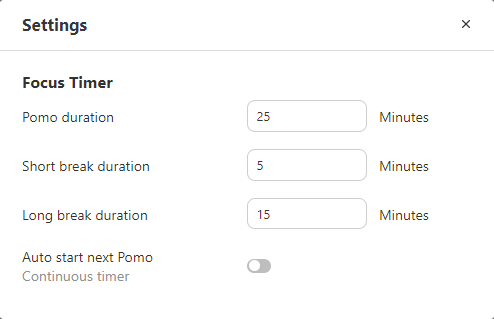
Once you kick off your timer, it must go off.
Upbase Tip:
To avoid distractions while you’re pomodoro-ing, add any requests that come in as new tasks, thoughts, or ideas to the Notepad, then check them later.
C. Repeat
To build a habit of Pomodoro planning, add a task in Upbase and set it recurring for each morning (or each night), so you’ll be reminded to plan out your pomodoros.
Use the daily journal to reflect on what you’ve accomplished, what you’ve learned, and what you could have done better.
3. More tricks to use Upbase effectively
A. How to Pomodoro a task with Upbase?
On the right side of the Focus Timer page, you’ll see all the day’s to-dos.
To Pomodoro any of them, hover over that task and click this button:
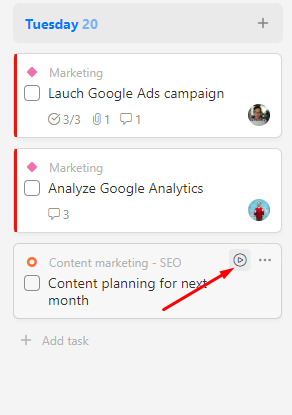
A new Pomodoro will start, and the task you’ve just picked will appear above the timer.
To Pomodoro a new task:
- Click “Add task”
- Add the task name and details
- Hover over the task and click this button:
To Pomodoro a task in your workspace, pop it open, click on the three-dot button on the top right corner, then select “Play focus timer”.
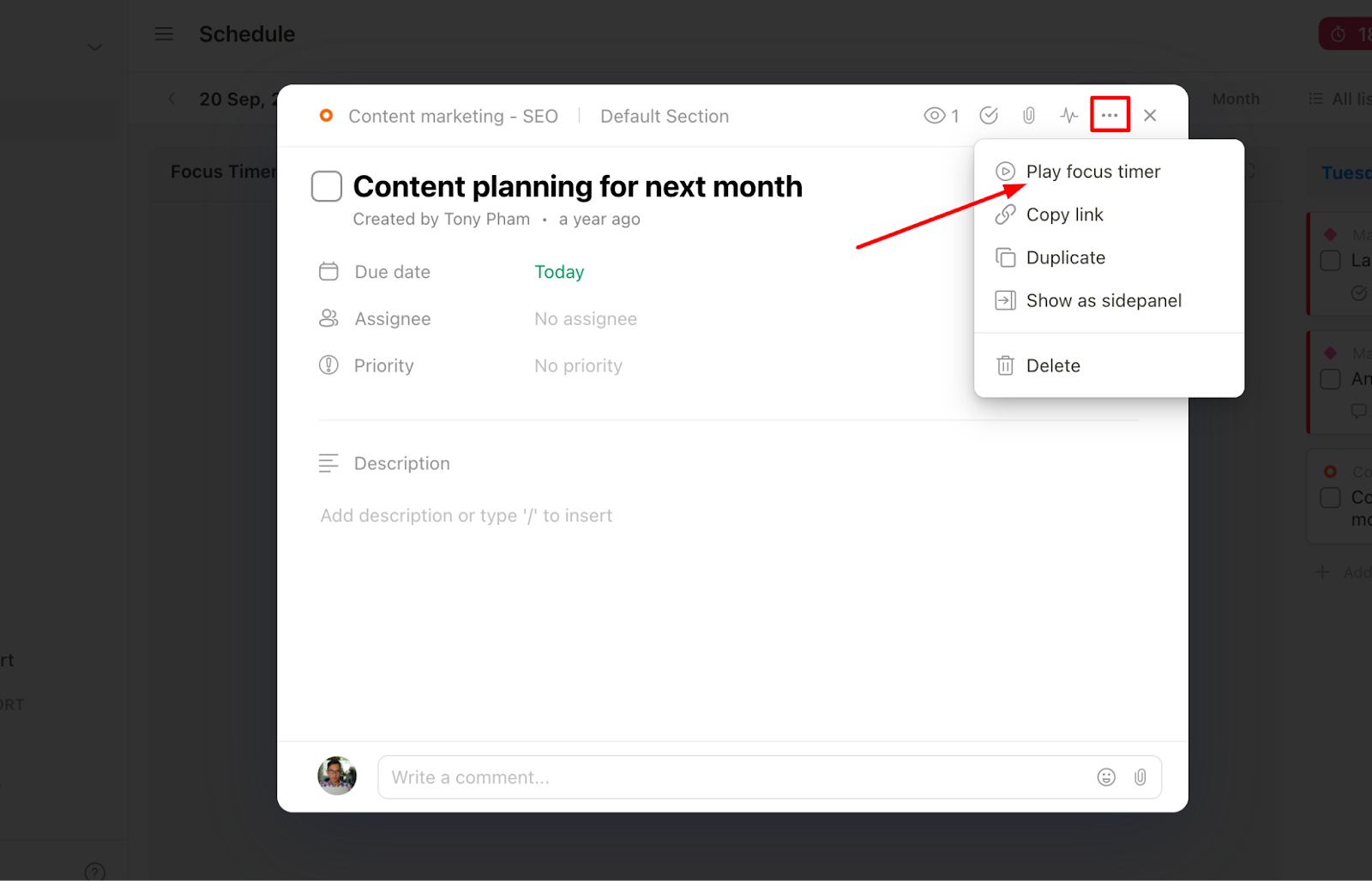
B. Upbase’s Notepad and Daily Journal
Notepad
Want to take notes along the way?
Upbase’s Notepad is a pleasure to use because it is quick to access, well-organized, and has rich formatting options to take notes your way.
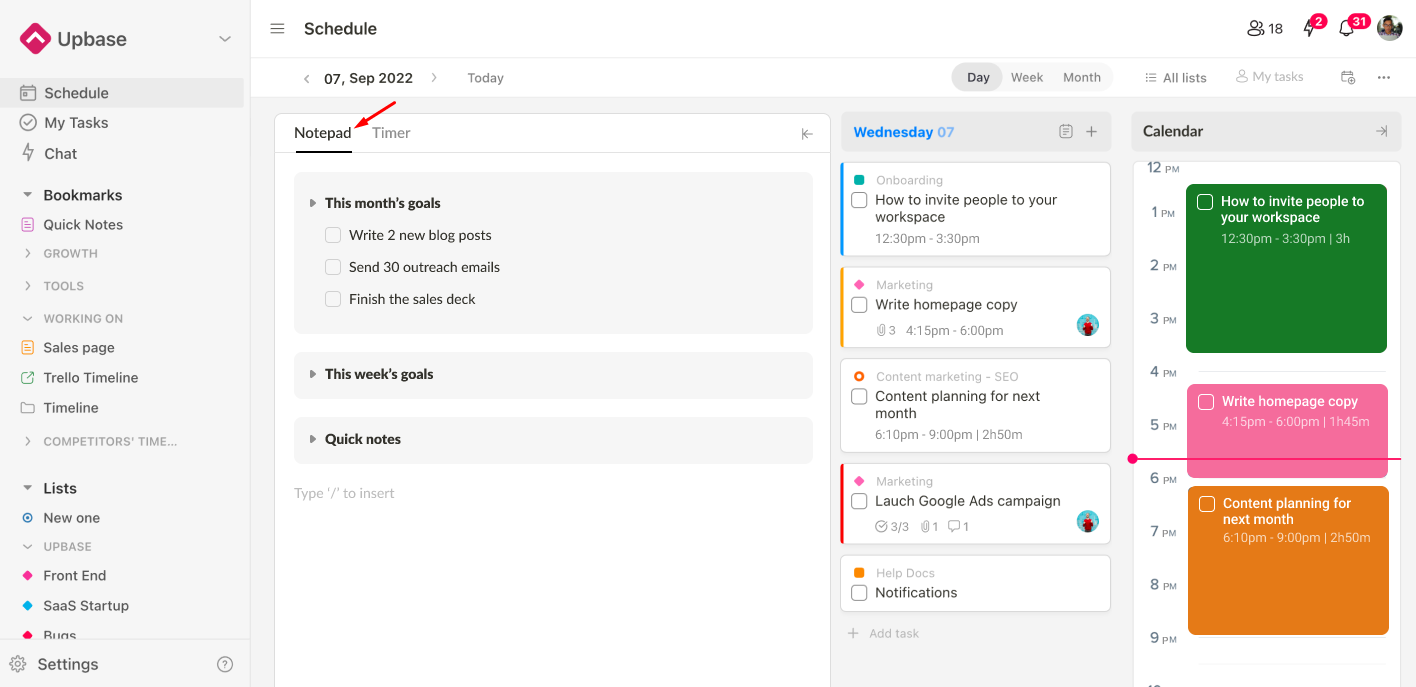
Highlight text or use slash commands to add colors, bullets, checklists, headers, and more to format your notes.
Notepad is also a handy tool for you to capture any thoughts and ideas that come to mind quickly.
And it’s private to you.
Daily Journal
Reflect on your day with Upbase’s Daily Journal.
To access Daily Journal:
- Go to Schedule
- Select “Day”
- Select the daily journal button
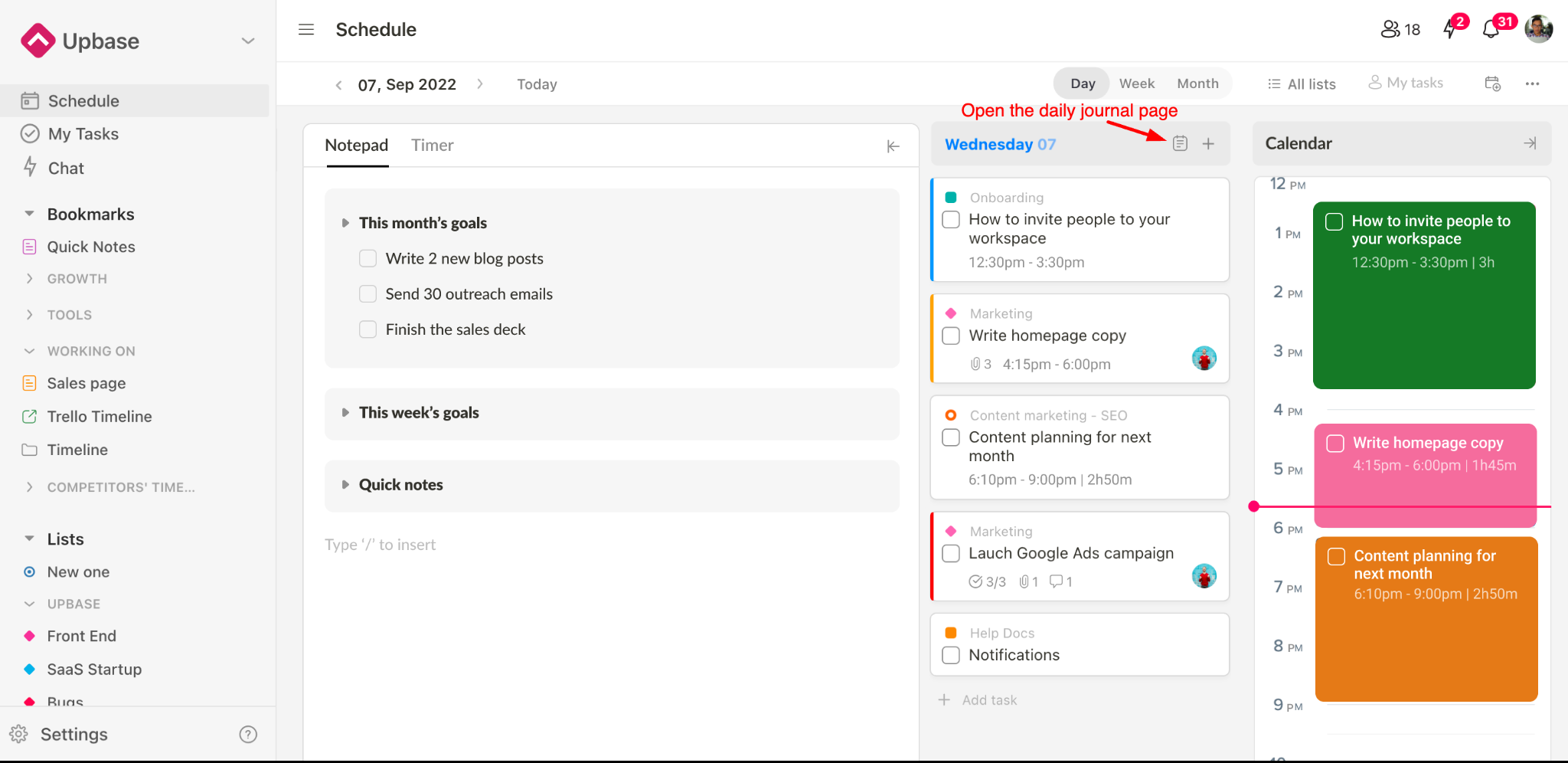
Again, it’s just you who can see your daily journal.
C. Make the Focus Timer page go fullscreen
To make the Focus Timer page go full screen, press this button:
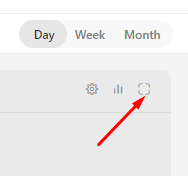
Click that button again or press “Esc” to exit the full computer screen.
Want to try the Pomodoro technique?
It’s very simple to get started with the Pomodoro technique, just choose a task, kick off a timer, and start working.
But if you want to double your productivity rates, use a dedicated Pomodoro tool!
Of all the options available, Upbase is the best to start with. It is a simple and effective implementation of the Pomodoro technique with no learning curve. Anyone – even a novice user – can start using it with ease.
Upbase is forever-free.
Don’t put your goals off any longer, sign up now and start making your Pomodoro planning a daily routine and weekly routine.
